

Patient and Family Planning Guide
Thank you for choosing us to take care of your child. Below you will find an outline of what to expect before, during, and after your child’s surgery. There is also a description of actions that Packard Children’s has taken to keep you and your child safe during COVID-19.
Introduction
To help reduce the spread of COVID-19, we asked many of our families to postpone procedures. Now, with support from local health officials, Stanford Children’s Health is starting to schedule many of the delayed procedures.
We understand that many families have concerns about coming to the hospital during these uncertain times. We want to let you know that we continue to provide high-quality care to our patients, families, and community. We are in constant contact with local health officials to monitor COVID-19. Your safety and your child’s safety remain our top priority.
Thank you for choosing us to take care of your child. Included in this brochure you will find: an outline of what to expect before, during, and after your child’s surgery; and actions that Packard Children's has taken to keep you and your child safe during COVID-19. We are here to work with you and support you every step of the way. Knowing what to expect can help make things go smoothly on the day of your child’s procedure. We will use the word “procedure” in this guide to describe surgery or a medical intervention that requires anesthesia. Anesthesia is a combination of medications that puts your child into a sleeplike state.
How We Will Keep You and Your Child Safe
Packard Children’s has made many changes in the last few months to prevent the spread of infections, so you may notice some differences. Here are things we are doing to keep your family safe in the hospital and to reduce the spread of infection.
•
Limit
the number of people coming into the hospital
We changed our visitor policy to limit the number of people in the hospital and at the bedside. Only one caregiver is allowed at the bedside for each child. No other visitors are allowed.
• Complete health checks
Upon entering the hospital, the information desk will ask you if you have any COVID-19 related symptoms. Please let your child’s nurse know if you experience any COVID-19 symptoms during your child’s stay at Packard Children’s.
• Provide masks for patient and caregiver
We ask that everyone wear a mask. This can help prevent the spread of germs. Our team has a mask for you.
• Do video visits instead of in-person visits
To make sure that we follow all social distancing rules, care teams may have a video visit with your family before the procedure. We can do this using the iPad in the room or your smartphone, mobile device, or computer.
• Discharge planning
The care team will work with your family when you are ready to leave the hospital. Information will be provided about safe ways to return home with your child. This will help lower the risk of COVID-19 infection and help in recovery.
• Take extra care with cleaning
We regularly clean our rooms and common spaces. Due to concerns around COVID-19, we are cleaning these spaces more often and taking extra time. While you are here, you might see more of our housekeeping team around the hospital.
• Special units for COVID-19 patients
We have a unit set aside for patients who have tested positive for COVID-19. Having this space reduces the spread of infection and helps families to heal in this difficult time.
COVID-19 testing for patients
All patients at Packard Children’s are tested, even if they do not have COVID-19 symptoms. Testing will occur when the child is admitted and also before procedures and diagnostic imaging.
Why testing is important
Patients may have COVID-19 before they start to feel sick. It can take 2 to 14 days after someone is exposed for symptoms to show up. Knowing if someone is COVID-19 positive will help us prepare for your child’s visit in the safest way.
When and where you will go for testing
A member of your child’s care team will call to schedule an appointment for testing. During that phone call, he or she will tell you where to go to get tested. You may go to a drive-through test site or have the test in the hospital.
What the test includes
When you and your child arrive at the test site, the care team will be wearing masks, gloves, eye protection, and gowns. The COVID-19 test uses a swab, like a long Q-tip. The swab will be placed in your child’s nose for 10 seconds.
How you can help prepare your child
This test will irritate the nose and will feel uncomfortable. Sneezing, coughing, and watery eyes are common after the swab is removed. Some things that might help your child during the test are:
• Letting him know you will be there to help him
• Telling him to take deep breaths
• Listening to music she enjoys
• Holding her hand, or holding her in your arms if she is smaller
When you get the results
The Packard Children’s laboratory will process the COVID-19 tests. Results are reported within a few hours. All results will appear in MyChart if your child has an account.
Results negative for COVID-19
If the test is negative, care for your child will continue as planned. You can assume that the results are negative if you do not get a call from the care team.
Results positive for COVID-19
• Your child’s care team will call to tell you the results. The results will also be in your child’s MyChart account.
• Your child’s care team may still do the procedure. If the procedure is urgent, the team will tell you the precautions that will be taken, including:
° Use of special personal protective equipment for the care team, patient, and caregiver
° Placement of the child in a special unit to prevent spread of COVID-19
° County reporting for public health safety
• Your child’s care team may delay the procedure. If the procedure is not urgent, the care team will tell you how to quarantine at home. The care team will work with you to make sure that your child gets the right care.
Coming to the Hospital
Health checks at the front desk
We do health checks at the entrances of both Main and West buildings. Everyone who enters the hospital is checked for COVID-19 related symptoms, such as:
• Fever
• Chills
• Cough
• Shortness of breath
• Headache
• Extreme fatigue or muscle aches
• Loss of smell and/or taste
• Runny nose
Keeping space between you and others
• Sneezing
• Diarrhea
• Nausea
• Vomiting
Social distancing is when you put physical space between you and other people. Keeping 6 feet (2 meters) of space between you and others is one of the best ways to prevent the spread of infection. During your stay, you may notice fewer members of your child’s care team visiting you in person. Your care team may talk to you by phone or through video visits.
You may also notice that when a provider comes into the room, he or she will stand farther away from you. This is to make sure that the provider maintains the right physical distance. We want to make sure that your child has the best medical care possible, but not everything can be done at a distance. The team will do physical exams when they need to, but they will use precautions to minimize exposure to infection.
Wearing masks in the hospital
At Lucile Packard Children’s Hospital Stanford, we will ask that you and your child wear a mask while you are here.
• Get a mask from the front desk. We have masks for you upon arrival at the hospital. If your child is able to, the care team will ask him or her to wear a mask as well. We know that cloth masks or covers are common when you are outside of your home. Our care team will ask you to wear one of the masks provided by Packard Children’s.
• Wear your mask at all times around other people. You may remove your mask when you are in your child’s room after his or her procedure. Masks will be required if you leave the room or visit common areas like hallways, elevators, the cafeteria, and the lobby.
• Ask your nurse for a new mask if you need one. If your mask gets dirty, wet, or damaged, ask your child’s nurse for a new one.
What to Expect at the Hospital
Caregivers at the bedside
One change we made early on was to limit the number of people coming into and going out of the hospital.
For COVID-19 negative patients
• Only one caregiver can be with his or her child at the bedside.
• All caregivers must be 18 years of age or older.
• If your child needs to stay for a few days, you can switch with one other person. Only two caregivers will be identified for each patient.
• Caregivers can switch every 24 hours. To help keep track of everyone coming into the hospital, we require all caregiver swaps to be done between 4:00 p.m. and 6:00 p.m. each day.
For COVID-19 positive patients
• Only one caregiver can be with his or her child at the bedside.
• Caregivers cannot switch.
• The care team will ask caregivers to stay in their child’s room while in the hospital and to wear protective gear.
All other visitors
At this time, we are not allowing any other visitors, like extended family or siblings, in the hospital. We know this will be hard for many families. Having fewer people in the hospital helps keep your family safe and reduces the risk of exposure to COVID-19.
Video visits
We understand how important it is for you to get support from friends and family during your child’s procedure. We recommend that you stay connected with video calls.
Before your child’s procedure, we recommend:
• Talking to friends and family about how you want to connect during your time at the hospital.
• If you want to make video calls, choose an app to use (such as Zoom or FaceTime). Download it to your phone or laptop.
• Do a few test video calls with friends and family at home, before you come to the hospital.
• Bring chargers for your phone, iPad, and/or laptop.
How Packard Children’s Hospital is keeping our staff safe
Making sure that our patients and families are safe goes hand in hand with making sure that our health care workers are safe. Here are some of the things we are doing:
• Testing for all providers
Doctors, nurses, and other providers directly treating your child are tested for COVID-19.
• Daily health checks
We do health checks with all team members every day to make sure that they do not have any COVID-19 symptoms.
• Supplying protective equipment for all of our providers
Packard Children’s provides masks, gowns, and gloves for everyone on your child’s care team. You might see more team members wearing these items in the halls and common areas. This is to help protect your family and our team from infection.
• Updating policies and practices often
We work closely with local and national health officials to make sure that we have the right practices and policies in place to protect patients, families, and the staff.
Preparing for Your Child’s Surgery
Thank you for choosing us to take care of your child. Below you will find an outline of what to expect before, during, and after your child’s surgery.
Tips for preparing your child for surgery
• Keep explanations simple, honest, and age-appropriate.
• Encourage your child to be involved. Let your child choose items to bring to the hospital (e.g., things to do, comfort items).
• Have a plan for the return home. Include your child by letting him or her choose a postsurgery treat or activity.
• If you need assistance on how to prepare your child, please contact the Child Life office at (650) 497-8336.
• Only parents or guardians are allowed in the Treatment Center. Please make prior arrangements for supervision of other children.
Before Surgery
Follow the instructions given to you by your provider, including:
• Schedule and complete any tests or office visits the doctor requests.
• Before surgery, you will need to register your child with our hospital. You will get instructions about registration when you schedule your child’s surgery. To preregister by phone, call (650) 497-8229. This service is available 24 hours a day, 7 days a week. You will need to have your child’s insurance information available.
• Have nonspicy, nongreasy foods available at home for after the surgery.
• Please trim your child’s nails to prevent infection and reduce scratching.
• If your child is a girl who is 12 years old or older or has started her period, be prepared to have her provide a urine sample to pre-op when she arrives.
If your child develops a fever, rash, cough, diarrhea, sore throat, skin lesions, or pink eye within 72 hours of scheduled surgery, call your surgeon or PARC:
• Monday through Friday between 9 a.m. and 5 p.m., call (650) 736-7359.
• After 5 p.m. Monday through Friday or on weekends, please call the Operating Room Control Desk at (650) 721-2820.
If you need to cancel your surgery for personal reasons, call the surgery scheduler. If it is the day before, call (650) 736-7359.
Pediatric Anesthesia Resource Center (PARC) phone call appointment
You will receive two phone calls from PARC. About 30 days before your child’s surgery, the surgery scheduler will work with you to schedule the first phone call. The appointment will take place one to three weeks before your child’s surgery. Please provide a current phone number to the scheduler. If possible, please provide a cell phone number so that we can send you a text reminder of the appointment. This call will last approximately 20 to 30 minutes, depending on the complexity of the patient’s history.
Patients who are 18 years old or older will need to provide the information during the PARC call, unless they give verbal permission for a parent to provide the information to a PARC nurse.
The following information will be discussed during the call:
• Your child’s family, medical, surgical, and social history.
• Your child’s diet and any dietary restrictions.
• The current list of medications your child is taking, including the doses.
• A comfort plan for the day of the procedure/surgery, including anesthesia and pain management.
• The discharge plan.
The Night Before Your Procedure/Surgery
Second PARC phone call
The day before your child's surgery, you will receive the second phone call from the Pediatric Anesthesia Resource Center. This call will occur between 1 p.m. and 5 p.m. and usually lasts 5 to 10 minutes. Please have a pen and paper ready to take notes.
The following information will be discussed during the call:
• The time you should arrive at the Treatment Center. Please allow enough time for traffic, parking, and visitor badges. It is very important to arrive on time, or the surgery may have to be rescheduled. Your child’s arrival time is dependent on the age and severity of other patients who are also scheduled that day.
• A brief update on how your child is doing, including any recent fever, cough, cold, etc.
• The eating and drinking instructions specific to your child’s needs, including when to give medications, last time to give foods, and last time to give liquids. This can be written down on the Eating and Drinking Instructions page in this brochure (page 11).
• The address and location of the Treatment Center.
If you have provided your cell phone number, you may receive a text after 6 p.m. with a reminder of your arrival time and the time to stop giving your child food and drink.
Preparing the skin before surgery
A surgical site infection is an infection that occurs in the area where an operation has been performed. There are some things that you can do to lower the risk of your child developing a surgical site infection, such as reducing the bacteria (“germs”) on your child’s skin. Your clinic may give you some special disposable wipes moistened with 2% chlorhexidine gluconate (CHG) antiseptic solution to help prepare your child’s skin for surgery.
Information:
• Please read and follow these instructions for bathing and skin care the night before your child’s surgery.
• You might need a second adult to help you with this process.
• Have clean, freshly washed bed sheets, towels, and pajamas ready to use the evening before surgery.
• Do not shave any part of your child’s body the day before or the day of surgery.
• If you would like to warm the wipes before using, please place the closed packet in a bowl of warm water at bathwater temperature.
Directions:
1. The night before surgery, shower or bathe your child with soap and warm water, and wash his or her hair.
2. Dry your child with a clean towel.
3. Wait at least one hour to let your child completely dry before applying the wipes.
4. Open the package: Using clean scissors, cut off the end seal of the package and throw away the foam piece.
5. For each package, remove two cloths at a time, and place onto a clean surface.
6. Wipe your child’s skin as shown in the pictures on the next page. Use one wipe for each area of the skin as shown by the numbers in the diagram.
7. Avoid contact with eyes, ears, mouth, genitalia, and any cuts or open areas of the skin. But, DO wipe the superficial skin and groin area (the creases where the legs meet the body).
After care:
• Throw the wipes in a trash can.
• After using the wipes, let skin air-dry. Your child’s skin will feel sticky until dry.
• Do not rinse CHG off the skin before surgery.
• Have your child put on clean pajamas and sleep in clean sheets.
• After applying CHG wipes, do not have your child shower, bathe, or apply lotions, moisturizers, or other personal care products.
How to use CHG wipes on your child
For children less than 22 pounds (<10kg)
Use the 1st cloth on your child’s chest, both arms, back, and neck.
Use the 2nd cloth on both legs (back and front), the buttocks, and the groin area.
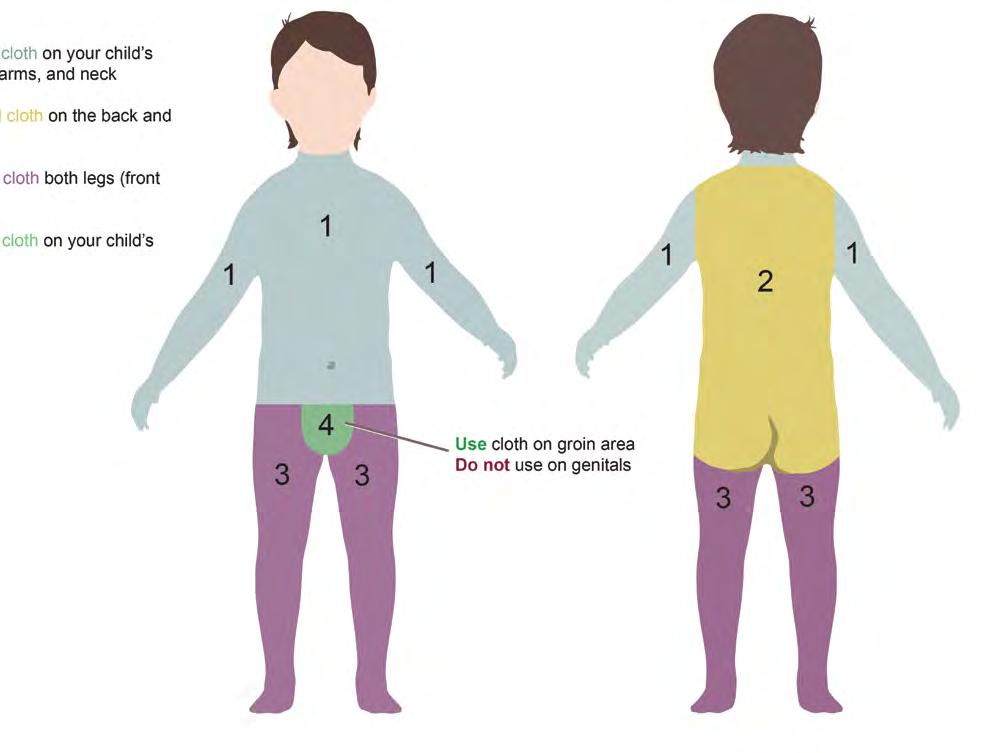
Use cloth on groin area
Do not use on genitals
For children between 22 and 66 pounds (10–30kg)
Use the 1st cloth on your child’s chest, both arms, and neck.
Use cloth on groin area
Do not use on genitals
For children more than 66 pounds (>30kg)
Use the 1st cloth on your child’s chest, both arms, and neck.
Use the 2nd cloth on the RIGHT leg.
Use the 3rd cloth on the LEFT leg.
Use the 4th cloth on the back.
Use the 5th cloth on the buttocks.
Use the 6th cloth on your child’s groin area.
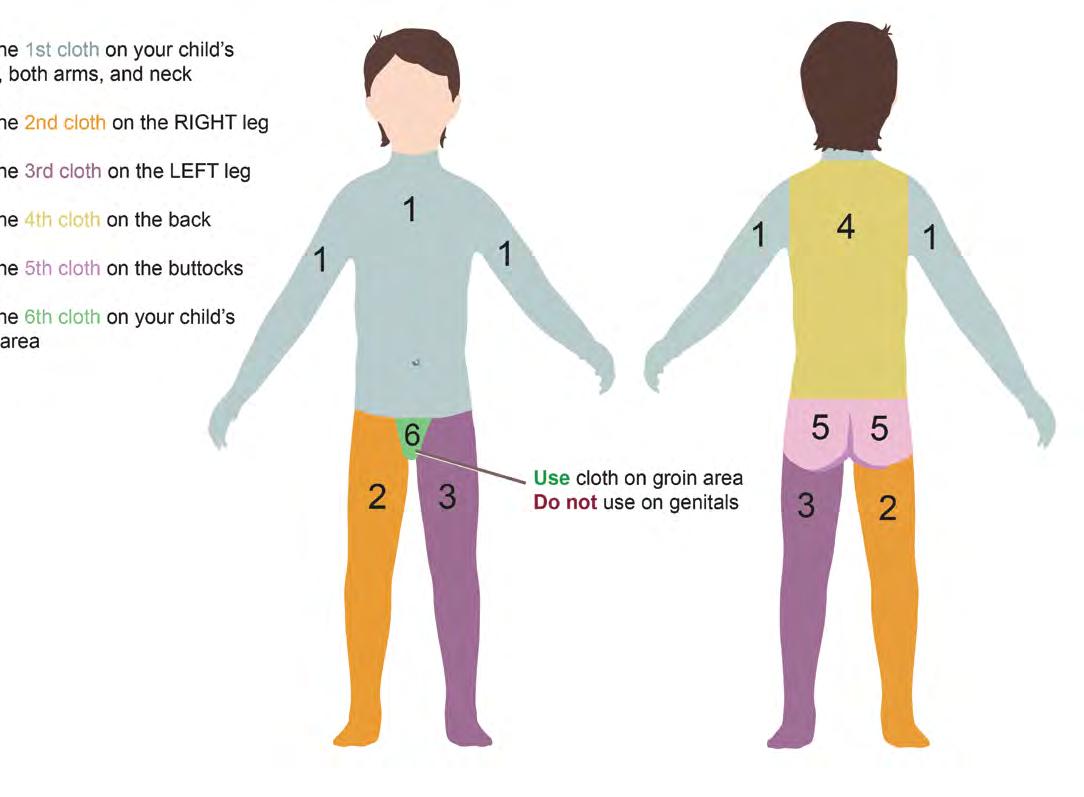
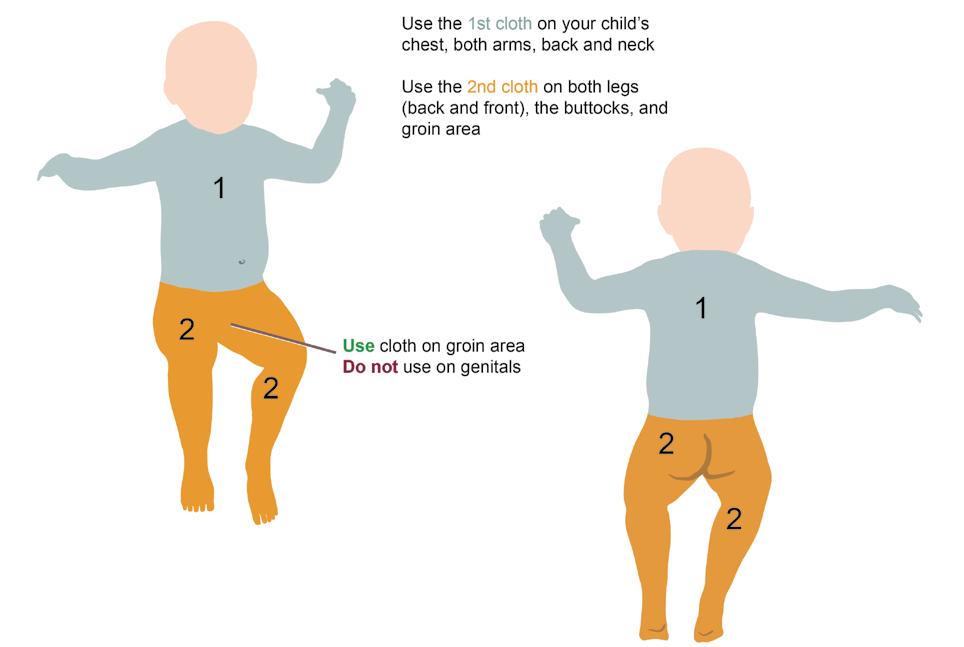
Use the 2nd cloth on the back and buttocks. Use the 3rd cloth on both legs (front and back).
Use the 4th cloth on your child’s groin area.
Use cloth on groin area
Do not use on genitals
Eating and drinking instructions
Eating and drinking instructions, sometimes called NPO instructions, for surgery and procedure patients are listed below. These must be strictly followed to keep your child as safe as possible. If these instructions are not followed, your child's surgery or procedure may be delayed or canceled.
Please read the following information carefully.
Except for emergencies, your child's stomach should be empty when anesthesia is started. This helps prevent vomiting, which may cause food or stomach acid to get into the lungs.
Follow the instructions that the Pediatric Anesthesia Resource Center, or PARC provider, has given you. A small number of children will receive special instructions different from these, depending on their medical needs.
We encourage your child to drink clear liquids up until your arrival time. It is important to make sure your child is hydrated and has enough liquids in their body. This will keep them comfortable and help with their recovery after surgery. Clear liquids include only water, Pedialyte, Gatorade, and clear apple juice. The apple juice cannot be cider or have pulp. Have your child drink clear liquids up until the time they are scheduled to arrive at the hospital. Keep taking prescribed medicines with a small sip of water unless the care team tells you to stop.
STOP food and candy at 12 a.m. Midnight .
Food includes anything that’s NOT formula, milk, breast milk or clear liquids.
STOP formula and milk when your Care Team tells you to stop.
STOP breast milk when your Care Team tells you to stop.
STOP all clear liquids at the time you are told to arrive at the hospital. Clear liquids include only water, Pedialyte, Gatorade, and clear apple juice. The apple juice cannot be cider or have pulp.
Day of the Surgery
What to bring to the hospital
On the day of surgery, please bring the following:
Valid photo identification, such as your driver’s license, California ID, or passport. If your child is 18 or older, bring a valid photo identification for him or her. Insurance, pharmacy, and Health Savings Account (HSA) card(s) for you and your child. A list of all medications that your child takes regularly, including doses, both prescribed and over-the-counter.
Your child’s favorite toy, blanket, or comfort item; a music or game player, and headphones.
If your child is an infant, please bring formula or breast milk in a cooler for after surgery. Bring your favorite book or activity so you have something to do while your child is in surgery.
Important tips for the day of surgery
• Parents: Please eat on the day of surgery so you are better able to care for your child, but do not bring food into the Treatment Center.
• Please arrive on time to avoid cancellation of your child’s surgery.
• Continue to encourage your child’s involvement, including picking a movie to watch, preparing his or her anesthesia mask, choosing a distraction for IV placement, etc.
• Occasionally you may have to wait longer than expected. Please understand that we will do everything we can to make you and your child comfortable during this wait.
Arrival
• Please park in the Main building.
• Valet parking is free on the day of the procedure/surgery.
• You will need to get a badge at the front desk of the hospital when you arrive.
• Go to the Treatment Center to check in.
Once you arrive at the Treatment Center
• While you are checking in, we strongly encourage you to change your pharmacy to the hospital’s pharmacy for your child's discharge medications. This will guarantee that you have your child's medications with you when you leave. Also, some medications will be difficult to fill at your local pharmacy. You can change it back at your next appointment.
• After check-in, you will be taken to an exam room, where a nurse will review your child’s medications, health, and allergies. The nurse will also ask you when your child last had anything to eat or drink, and you will be asked to review the consent form you signed.
• For safety, you will be asked many times to provide your name, your child’s name, the type of surgery being done, and the last time your child ate or drank anything.
Important information to know
• Your child may also be seen by child life specialists, who will help your child understand and cope with his or her visit to the hospital.
• Before surgery, your child may be given medication to help him or her relax.
• Your physician will decide the safest way to provide anesthesia to your child. Please ask about pain management options.
• For some children, an IV will be placed. An IV is a tube that goes in your child’s vein to deliver fluids and medications; we will talk about ways we can help your child cope with this IV placement.
• When your child goes into surgery, you will be taken to the Treatment Center Waiting Room, located near the check-in area. In this waiting room, you will be shown how to track your child’s journey during surgery.
• You will be told when your child’s surgery should be completed. Plan to return to the Treatment Center at or before that time so you can meet with your child’s surgeon.
During surgery
• To keep your child asleep during the surgery, he or she will be given anesthesia medicine through a mask, an IV, or both.
• Monitors will be placed on your child’s body to read vital signs during surgery. These include blood pressure, breathing, blood oxygen level, and heart rate.
After Surgery
• When the surgeon is finished, he or she will meet with you in one of the consult rooms located near the Treatment Center Waiting Room.
• Once the surgery is completed, your child will be taken to the recovery area, where he or she will rest under the care of nurses until the anesthesia wears off. The length of time your child will spend in the recovery room may be different from other patients because some children take longer than others to wake up completely after anesthesia.
• Our goal is to get you back with your child as soon as possible. Once your child is settled, a staff member will come and take you to the recovery area.
• Children wake up from anesthesia in different ways (sleepy, excited, having an upset stomach). Your anesthesia provider and recovery room nurses will make sure your child is safe during this time.
• Medication may be given to your child to help ease his or her pain.
• Your child may be offered something to drink.
Going home
• Before you go home, a nurse will give you instructions on how to care for your child at home.
• A parent or legal guardian must take your child home.
• Your doctor may prescribe a medication, which may be filled at our outpatient pharmacy located here in our hospital.
Use MyChart to easily manage the health care needs of you or your family at any time from your computer or smartphone. For no additional cost, with MyChart you can:
New Users: How to Create Your MyChart Account
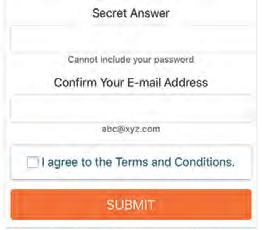
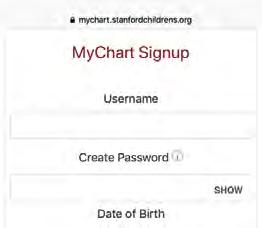
Your
•
•
•
•
•
•
•
•
MyChart support is available 24 hours a day, 7 days a week. Spanish-speaking representatives are available. For questions or concerns, or to add more than one child under an account, please call (877) 339-9895 or chat with an online representative.
Visit mychart.stanfordchildrens.org or download the MyChart app for your mobile device
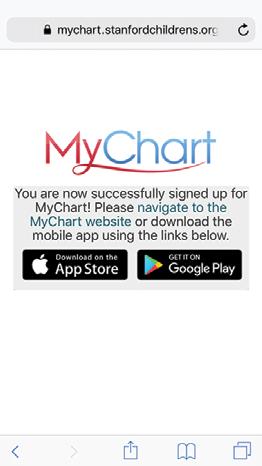
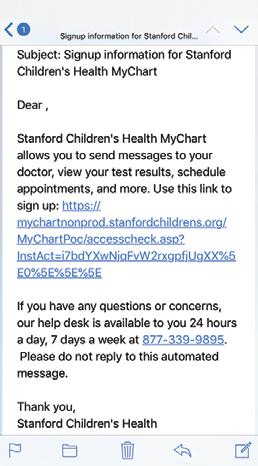
Checklist
Review the new COVID-19 policies: Review caregiver and visitor rules. Learn about COVID-19 testing. Know about health checks at check-in. Learn about social distancing in the hospital. Read about masking policy.
MyChart: Register for a MyChart account. Download MyChart on your phone or tablet.
Communicating with friends and family: Pick an app for talking to friends and family. Test video calls before you come to the hospital.
Preparing for surgery:
Talk to your child about what to expect. Register at Packard Children’s Hospital.
Call your team if you notice any new symptoms. Talk to PARC (Pediatric Anesthesia Resource Center).
Know the caregiver rules.
The night before surgery:
Talk to PARC about diet and when to arrive.
Wash your child with CHG wipes given to you by the team. Collect the following:
Photo ID for you and for children over 18 years of age.
Insurance, pharmacy, and Health Savings Account cards.
List of your child’s medications.
Your child’s favorite toy, blanket, or game player.
For infants, bring formula or breast milk in a cooler.
Medical acronyms
• CHG = Chlorhexidine gluconate
• IV = Intravenous, a solution administered directly into the vein
• NPO = Nothing through the mouth, withhold food and fluids
• OR = Operating room
• PARC = Pediatric Anesthesia Resource Center
